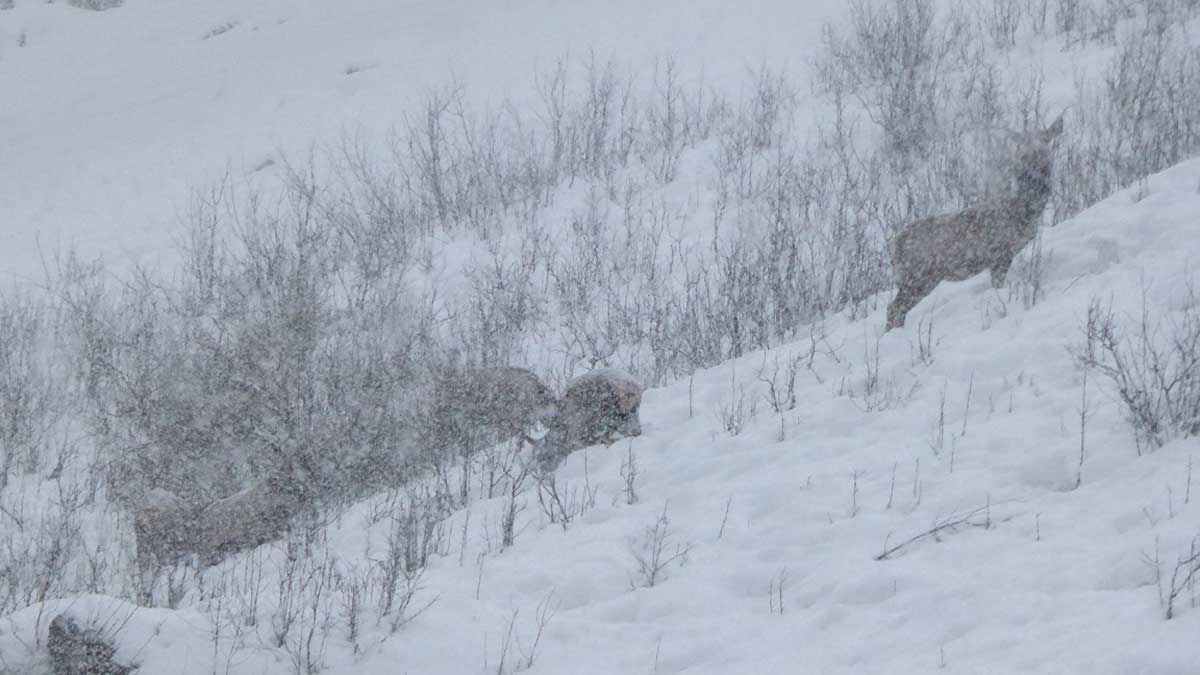Below is a news release from the Idaho Department of Fish and Game.
Out of sight, out of mind, right? Wrong. Just because wildlife aren’t as visible as they were in the shoulder seasons doesn’t mean they’re “living easy” on their wintering grounds. And if you are seeing wintering wildlife, you may be too close for comfort, which brings us to our next point: Protect wintering wildlife by leaving them alone during the winter.
Winter is a hard time for Idaho’s wildlife, especially for big game animals, like deer and elk, that migrate to lower elevations and spend winter closer to people than during other seasons.
As the snow deepens, forage starts to get limited, and animals usually can’t meet their full nutritional needs by feeding on naturally available food, even at lower elevations where the ground isn’t snow covered. Deer, elk and other big game animals accumulate fat reserves earlier in the year that typically allows them to survive most Idaho winters, but even the healthiest animals’ limited reserves can be depleted, with fawns and calves being the most susceptible to malnutrition and winterkill.
During an average winter without extreme cold or unusually deep snow, more than 90 percent of adult deer and elk survive. But that number can be significantly lower for fawns and calves, which are smaller and less capable of withstanding winter. On average, about 40 percent of mule deer fawns perish during a normal Idaho winter — and more during a harsh one.
One way to avoid disturbing wintering wildlife is simply leaving them alone when you’re outdoors. A simple rule of thumb is if your presence or actions cause them to move, you’re too close.
Control your four-legged hiking companion
Even if your dog isn’t chasing big game animals, its presence may be enough to cause animals to flee and expend unnecessary energy they would not have otherwise used.
A dog can be seen as another predator in the eyes of big game animals, and the impacts of free-running dogs on wintering game can be substantial. Remember: It is illegal to allow dogs to chase or harass big game.
Watch for big game along roads and highways
Auto collisions involving big game animals usually tick upward during winter, so drivers should practice extra caution, especially when traveling during the busy holidays.
“Being watchful is the best defense against a wildlife/vehicle collision,” said Roger Phillips, Fish and Game Public Information Supervisor. “Drivers should be especially careful during times of low visibility. Collisions with wildlife are a serious matter and best avoided.”
Wildlife collisions are not only harmful, they are expensive. Hitting a deer or elk often results in thousands of dollars in vehicle damage, not to mention potential injury to vehicle occupants and loss of wildlife.
Follow these tips to help reduce your chances of an animal collision:
Game animals are especially active at dawn, dusk and at night, so be extra watchful and cautious during those times.
Scan ahead and watch for movement, especially near the fog line and side of the road. When driving at night, use your brights when appropriate and watch for shining eyes in headlights.
If you see one animal cross the road, slow down immediately and look for more to follow. They usually aren’t alone.
Pay extra attention in areas posted with wildlife crossing signs, which signify common migration areas, or areas where big game winters.
Don’t swerve and risk losing control of your vehicle. Brake as much as possible, but stay on the roadway. The most serious crashes often occur when drivers lose control of their vehicles while trying to avoid an animal.
Don’t feed wintering big game
It may seem counterintuitive when there’s limited food available for deer, elk and other animals, but feeding big game can cause big problems, even when the intentions come from the right place.
Fish and Game’s policy is that natural habitat and feed must sustain wildlife, except in emergency situations. Regardless of the severity of winter, some animals will naturally perish. That’s an inescapable part of nature, and animals too stressed from winter can die even when food is available.
When big game animals are fed it can create a whole slew of problems. They can become habituated to handouts, change seasonal migrations, damage property, create traffic hazards and also attract predators, such as mountain lions. Congregated animals can also more readily transmit diseases, such as brucellosis and chronic wasting disease.
Fish and Game has plans in place if emergency feeding is needed
Winter feeding advisory committees in different parts of the state monitor weather conditions and make recommendations if Fish and Game crews should feed animals.
Other situations may also arise where emergency feeding is required, but the main policy is that Idaho’s wildlife should be self-sustaining and reliant on natural habitat, not supplemental feeding every winter.
If these situations occur due to extreme winter weather, the committees convene and make recommendations to Fish and Game whether to begin emergency winter feeding.
For more information on Fish and Game’s policy on winter feeding for big game animals, check out this story.
Moral of the story
At the end of the day, leave big game alone this time of year. It’s the hardest time of year to be a deer, elk or other wintering big game animal, and their livelihood literally gets chalked up to “every calorie counts.”
If you’re looking for a fun, frosty winterscape to take Rover out on a walk, do your research. Avoid places designated as wintering grounds for deer and elk. We live in a state full of public land access where you (and your four-legged trail buddy) can explore and help pass the time this winter.
(Photo credit: Idaho Department of Fish and Game)
